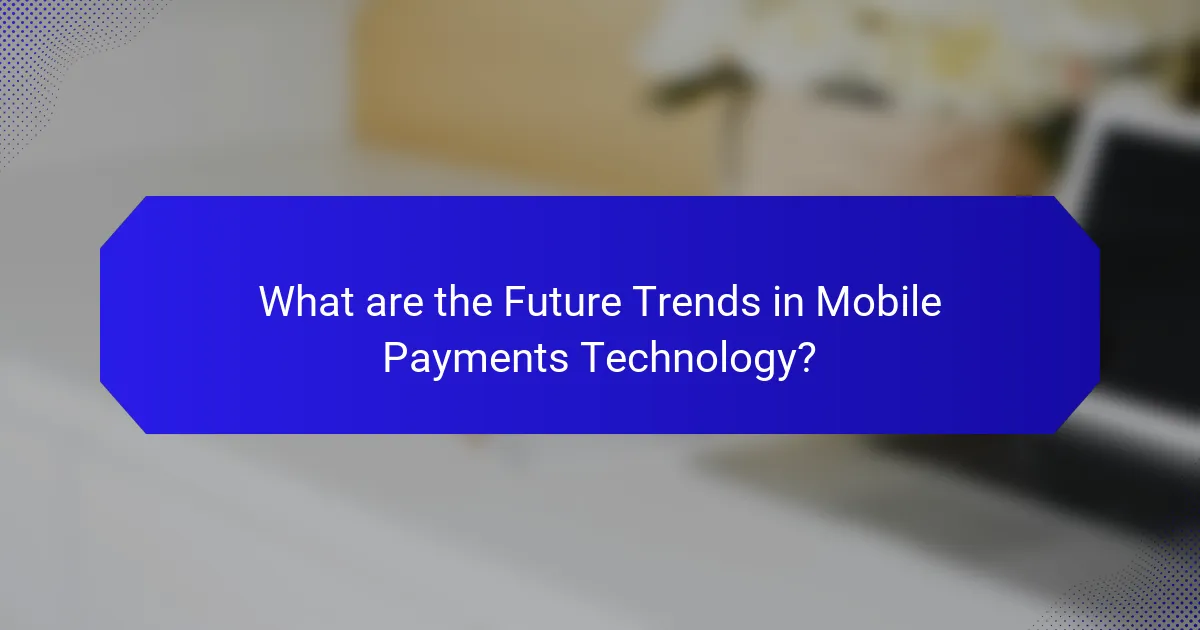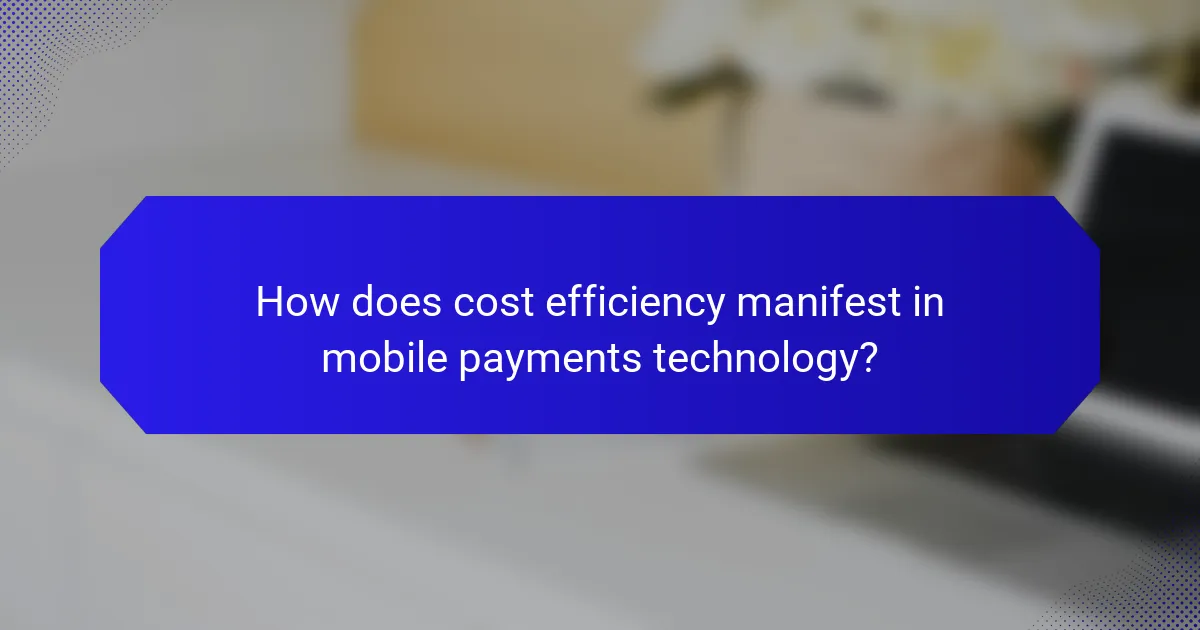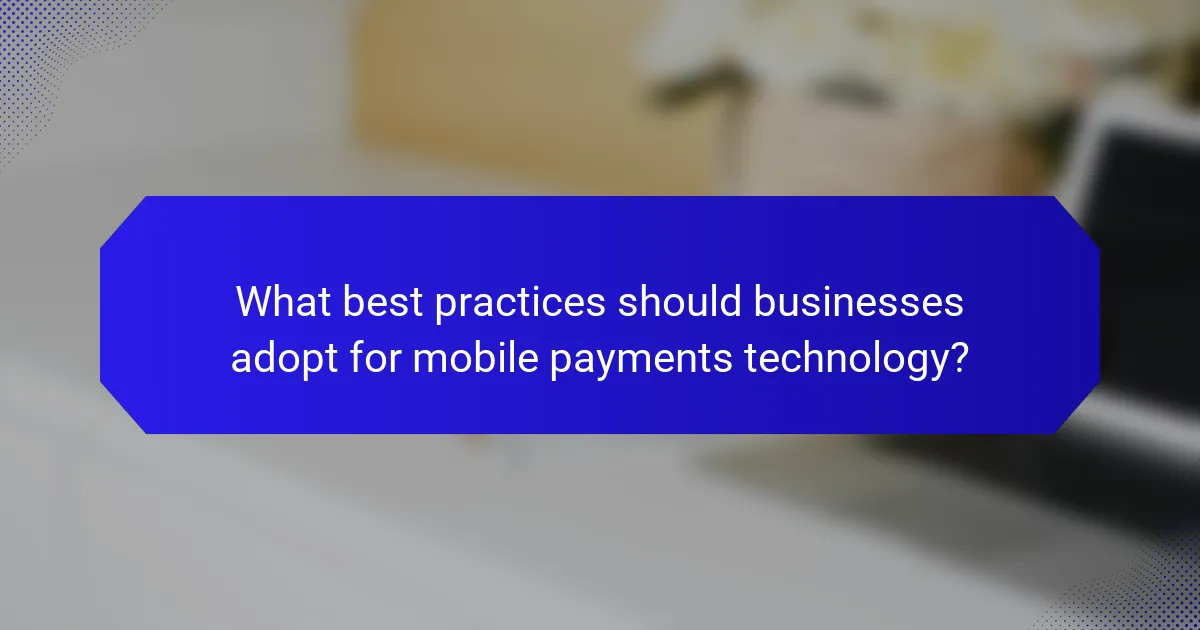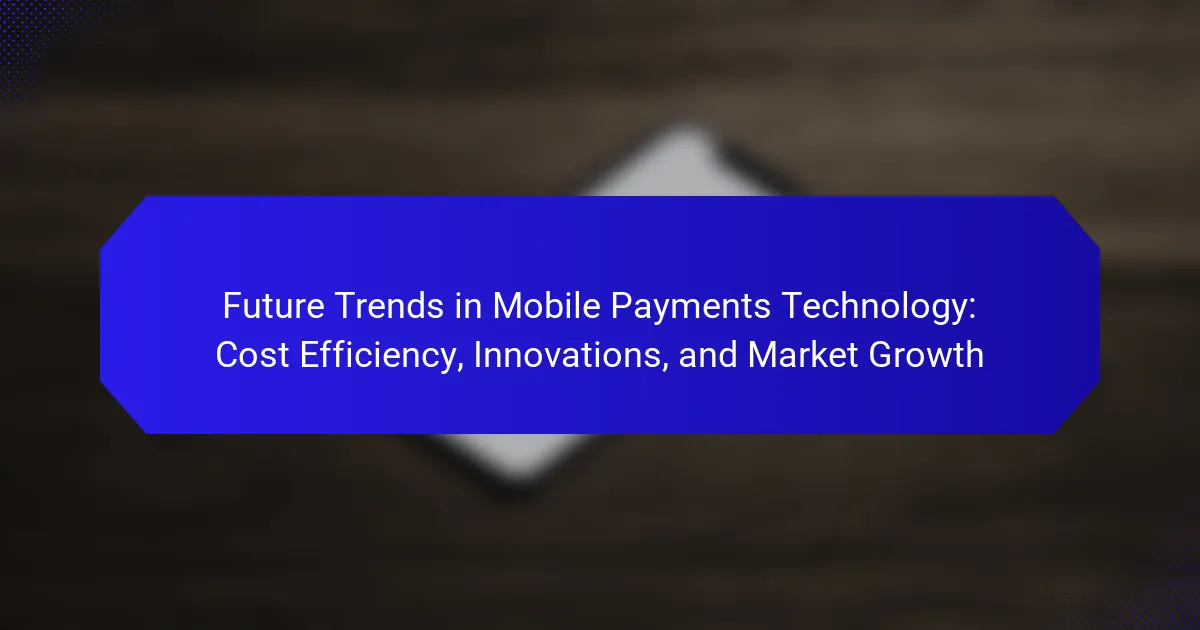The article focuses on future trends in mobile payments technology, highlighting the significant growth of contactless payments, the integration of artificial intelligence, and advancements in security measures. It discusses the projected increase in the global contactless payment market, expected to reach $1 trillion by 2024, and the role of AI in enhancing user experiences and fraud detection. Additionally, it addresses the cost efficiency of mobile payments, emphasizing reduced transaction fees and operational savings for businesses. The article also outlines best practices for businesses, including robust security protocols, user-friendly interfaces, and compliance with regulations, to foster customer trust and satisfaction in the evolving payment landscape.

What are the Future Trends in Mobile Payments Technology?
Future trends in mobile payments technology include increased adoption of contactless payments, integration of artificial intelligence, and enhanced security measures. Contactless payments are projected to grow significantly, driven by consumer demand for convenience. A report by Statista indicates that the global contactless payment market is expected to reach $1 trillion by 2024. Artificial intelligence will play a crucial role in personalizing user experiences and detecting fraud. Additionally, biometric authentication methods, such as [censured] recognition and fingerprint scanning, will likely become standard for secure transactions. The rise of digital wallets and cryptocurrencies will further transform the payment landscape, making transactions faster and more efficient.
How is cost efficiency shaping mobile payments technology?
Cost efficiency is significantly shaping mobile payments technology by driving innovation and adoption. As businesses seek to reduce transaction costs, they are increasingly leveraging mobile payment solutions. This shift leads to enhanced competition among payment providers, resulting in lower fees for consumers and merchants. According to a report by Juniper Research, mobile payment transactions are expected to reach $4.6 trillion by 2025, highlighting the growing demand for cost-effective solutions. Additionally, advancements in technology, such as blockchain and AI, are improving transaction speeds and security while lowering operational costs. These factors contribute to a more efficient payment ecosystem, benefitting both users and service providers.
What factors contribute to cost efficiency in mobile payments?
Cost efficiency in mobile payments is primarily influenced by transaction fees, operational costs, and technology adoption. Lower transaction fees reduce the overall cost for consumers and merchants. Efficient operational processes streamline payment handling, minimizing expenses. The adoption of advanced technologies, like blockchain, can enhance security and reduce fraud costs. Additionally, economies of scale achieved through higher transaction volumes can lead to lower per-transaction costs. Studies show that mobile payment systems can save businesses up to 2-3% in transaction fees compared to traditional methods.
How does cost efficiency impact consumer adoption of mobile payments?
Cost efficiency significantly influences consumer adoption of mobile payments. When mobile payment systems offer lower transaction fees, consumers are more likely to use them. A study by the Federal Reserve in 2021 indicated that 50% of consumers preferred payment methods with lower costs. Additionally, cost-effective mobile payment solutions attract small businesses, increasing overall market acceptance. Lower costs can also enhance user experience, driving higher transaction volumes. As consumers perceive greater value in cost-efficient systems, adoption rates rise. This trend is evident in markets where mobile payment platforms reduced fees, leading to increased user engagement and transaction frequency.
What innovations are emerging in mobile payments technology?
Innovations in mobile payments technology include biometric authentication, blockchain integration, and contactless payment advancements. Biometric authentication enhances security by using fingerprints or [censured] recognition. Blockchain integration allows for faster and more secure transactions through decentralized ledgers. Contactless payment advancements, such as NFC and QR codes, facilitate quicker transactions. These innovations aim to improve user experience and security. According to a report by Statista, the global mobile payment market is expected to reach $12 trillion by 2025, highlighting the significance of these advancements.
What role does blockchain play in mobile payments innovations?
Blockchain enhances mobile payment innovations by providing secure, transparent, and efficient transaction processes. It enables peer-to-peer transactions without intermediaries, reducing costs and transaction times. Smart contracts on blockchain automate payment agreements, ensuring trust and reliability. Additionally, blockchain’s decentralized nature increases security against fraud and hacking. According to a report by Deloitte, blockchain can reduce transaction costs by up to 40%. Furthermore, companies like Ripple are already integrating blockchain to facilitate instant cross-border payments. This technology’s ability to streamline operations positions it as a pivotal player in the future of mobile payments.
How are biometric technologies enhancing security in mobile payments?
Biometric technologies enhance security in mobile payments by providing unique user identification methods. These methods include fingerprint scanning, [censured] recognition, and iris scanning. Each biometric characteristic is difficult to replicate, making unauthorized access significantly harder. For instance, fingerprint recognition systems have a false acceptance rate as low as 0.001%. This high level of accuracy reduces fraud risks in mobile transactions. Additionally, biometric data is often stored locally on devices, minimizing the chances of data breaches. Overall, biometric technologies contribute to a more secure payment environment by ensuring that only authorized users can complete transactions.
What is the projected market growth for mobile payments technology?
The projected market growth for mobile payments technology is expected to reach $12.06 trillion by 2028. This represents a compound annual growth rate (CAGR) of 27.4% from 2021 to 2028. Factors driving this growth include increased smartphone adoption and advancements in payment technologies. The rise in e-commerce and contactless payment preferences also contribute significantly. A report by Fortune Business Insights highlights these trends and provides detailed market analysis.
Which regions are experiencing the fastest growth in mobile payments?
Asia-Pacific is experiencing the fastest growth in mobile payments. Countries like China and India lead this trend. In China, mobile payment transactions reached approximately $49 trillion in 2021. India saw a 111% increase in mobile payment users from 2019 to 2021. The rapid adoption is driven by increased smartphone [censured] and digital wallet usage. Additionally, Southeast Asian nations are also witnessing significant growth. Markets like Indonesia and Vietnam are expanding their mobile payment infrastructures rapidly. This trend is supported by the increasing availability of internet access and fintech innovations in these regions.
What demographic trends are influencing mobile payments market growth?
Younger demographics are significantly influencing mobile payments market growth. Millennials and Gen Z are more tech-savvy and prefer digital transactions. These age groups are driving the adoption of mobile wallets and contactless payments. According to a report by Statista, 45% of millennials use mobile payment methods regularly. Additionally, urbanization is increasing mobile payment usage, as city dwellers seek convenience. The rise of e-commerce also correlates with demographic shifts towards online shopping. Increased smartphone [censured] among all age groups further supports this trend. Overall, these demographic factors contribute to the expanding mobile payments market.
How do emerging technologies influence the future of mobile payments?
Emerging technologies significantly influence the future of mobile payments by enhancing security, convenience, and efficiency. Technologies like blockchain improve transaction security through decentralized ledgers. Biometric authentication, such as fingerprint and [censured] recognition, increases user verification speed and safety. Contactless payment systems, including NFC and QR codes, streamline transaction processes. Artificial intelligence optimizes fraud detection and customer experience through personalized services. The global mobile payment market is projected to reach $12.06 trillion by 2027, driven by these advancements. This growth indicates a clear trend towards increased adoption of mobile payment solutions.
What challenges does the mobile payments industry face in the future?
The mobile payments industry faces several significant challenges in the future. Security concerns remain a top issue, as cyber threats continue to evolve. According to a report by Cybersecurity Ventures, global cybercrime damages are expected to reach $10.5 trillion annually by 2025. Regulatory compliance presents another challenge, with varying laws across regions impacting operations. Additionally, consumer adoption rates are inconsistent, as some users remain hesitant to transition from traditional payment methods. Competition from fintech startups is intensifying, which may pressure established players to innovate rapidly. Finally, infrastructure limitations in certain areas can hinder the widespread implementation of mobile payment solutions.

How does cost efficiency manifest in mobile payments technology?
Cost efficiency in mobile payments technology manifests through reduced transaction fees and streamlined processes. Mobile payment systems often have lower fees compared to traditional banking methods. For instance, many mobile wallets charge minimal or no fees for transactions. This reduction in costs benefits both consumers and merchants.
Additionally, mobile payments eliminate the need for physical infrastructure, such as cash registers or card readers. This leads to savings on hardware and maintenance. Studies show that businesses can save up to 30% in operational costs by adopting mobile payment solutions.
Furthermore, mobile payments enhance transaction speed. Faster transactions lead to increased customer satisfaction and higher sales volumes. According to a report by Statista, mobile payment adoption is projected to reach $12 trillion by 2025, indicating a significant shift towards cost-effective solutions.
What are the key cost-saving benefits for businesses using mobile payments?
Mobile payments provide significant cost-saving benefits for businesses. They reduce transaction fees compared to traditional payment methods. Many mobile payment platforms charge lower fees than credit card processors. This leads to increased profit margins. Mobile payments also streamline the checkout process. Faster transactions enhance customer satisfaction and reduce labor costs. Additionally, businesses save on hardware expenses. Mobile payments often require less physical infrastructure than traditional systems. A study by the Federal Reserve found that mobile payments can lower operational costs by up to 20%. These factors combine to make mobile payments an economically advantageous choice for businesses.
How does mobile payments technology reduce transaction costs?
Mobile payments technology reduces transaction costs by streamlining payment processes. It eliminates the need for physical cash handling and reduces the reliance on traditional banking infrastructure. Transactions can be completed quickly through mobile devices, which lowers operational costs for merchants. Additionally, mobile payments often involve lower fees compared to credit card transactions. According to a study by the Federal Reserve, mobile payment systems can reduce transaction fees by up to 2% per transaction. This efficiency not only benefits consumers but also encourages merchants to adopt mobile payment solutions. The widespread use of mobile wallets enhances competition, further driving down costs.
What operational efficiencies can businesses achieve through mobile payments?
Mobile payments can enhance operational efficiencies for businesses by streamlining transaction processes. They reduce the time spent on cash handling and manual processing. Mobile payments facilitate quicker checkouts, improving customer satisfaction. According to a study by Juniper Research, mobile payment transactions are expected to reach $4.6 trillion by 2025. This growth indicates a shift towards digital solutions that save time and reduce errors. Additionally, mobile payments often come with lower transaction fees compared to traditional credit card processing. Businesses can also benefit from improved inventory management through real-time sales data provided by mobile payment systems. This data enables better forecasting and reduces excess stock. Overall, mobile payments contribute to a more efficient and responsive business operation.
How do innovations in mobile payments enhance user experience?
Innovations in mobile payments enhance user experience by providing faster transactions, increased security, and greater convenience. Users can complete purchases in seconds using mobile wallets. Technologies like Near Field Communication (NFC) enable contactless payments, reducing wait times. Enhanced security features, such as biometric authentication, protect user data and build trust. Innovations, like loyalty program integration, offer personalized rewards, improving customer satisfaction. According to a study by Juniper Research, mobile payment transactions are projected to reach $4.6 trillion by 2025, indicating a growing preference for these solutions. Overall, these advancements streamline the payment process and create a more efficient shopping experience.
What are the latest user-friendly features in mobile payment apps?
The latest user-friendly features in mobile payment apps include biometric authentication, instant money transfers, and customizable user interfaces. Biometric authentication enhances security by allowing users to access their accounts through fingerprints or [censured] recognition. Instant money transfers enable users to send and receive funds within seconds, improving transaction efficiency. Customizable user interfaces allow users to personalize their app experience, making navigation easier. Additionally, features like in-app budgeting tools help users manage their finances more effectively. These enhancements cater to user convenience and security, reflecting the evolving landscape of mobile payments.
How do innovations in mobile payments improve transaction speed?
Innovations in mobile payments improve transaction speed by utilizing technologies like NFC and QR codes. Near-field communication (NFC) allows devices to communicate instantly when in proximity. This reduces the time taken for transactions to mere seconds. QR codes facilitate quick scanning and processing through mobile apps.
Additionally, advancements in mobile wallets streamline the payment process. They store multiple payment methods, allowing users to transact without entering card details each time. Faster authentication methods, such as biometrics, also enhance speed.
According to a report by McKinsey, mobile payment transactions can be completed in under 10 seconds, compared to traditional methods which may take significantly longer. These innovations collectively reduce friction in the payment process, leading to quicker transactions.
What is the impact of mobile payments on traditional banking systems?
Mobile payments significantly disrupt traditional banking systems. They provide consumers with faster and more convenient transaction methods. This shift reduces reliance on physical bank branches. According to a report by the World Bank, mobile payment transactions grew by 14% in 2020. Traditional banks face increased competition from fintech companies offering mobile solutions. As a result, banks are investing in technology to enhance their services. The rise of mobile payments also encourages financial inclusion. It allows unbanked populations access to financial services through mobile devices.
How are banks adapting to the rise of mobile payments?
Banks are adapting to the rise of mobile payments by enhancing their digital infrastructure. They are investing in mobile banking apps to provide seamless payment experiences. Many banks are partnering with fintech companies to integrate advanced payment technologies. They are also implementing robust security measures to protect user data. According to a report by McKinsey, digital payment transactions have surged by over 40% in recent years. Banks are also focusing on customer education regarding mobile payment options. They are offering incentives for customers to use mobile payments, like cashback rewards. Overall, banks are evolving to meet the growing demand for convenient payment solutions.
What partnerships are forming between banks and mobile payment providers?
Banks are forming strategic partnerships with mobile payment providers to enhance digital payment solutions. These collaborations aim to improve customer experience and streamline transactions. For instance, major banks are partnering with providers like PayPal and Venmo to integrate their services. This integration allows banks to offer seamless payment options within their mobile apps. Additionally, partnerships are emerging between banks and fintech companies to leverage innovative technologies. These alliances often focus on security enhancements and fraud prevention measures. The trend reflects a growing demand for efficient and user-friendly payment methods in the digital economy. Recent data indicates that such partnerships are expected to drive significant growth in mobile payment adoption.

What best practices should businesses adopt for mobile payments technology?
Businesses should adopt several best practices for mobile payments technology. First, they must ensure robust security measures. This includes encryption and tokenization to protect sensitive data. Regular security audits help identify vulnerabilities. Additionally, businesses should offer multiple payment options. This caters to diverse customer preferences and enhances user experience.
Integrating with existing systems is crucial for seamless transactions. Businesses should also prioritize user-friendly interfaces. A simple, intuitive design encourages customer engagement. Furthermore, businesses must stay updated on compliance regulations. Adhering to standards like PCI DSS is essential for legal operation.
Finally, businesses should analyze transaction data. This provides insights into customer behavior and payment trends. Implementing these best practices can lead to increased customer trust and satisfaction.
How can businesses ensure security in mobile payments transactions?
Businesses can ensure security in mobile payments transactions by implementing strong encryption protocols. This protects sensitive data during transmission. Utilizing tokenization replaces card details with unique identifiers. This reduces the risk of fraud. Regular software updates help to fix vulnerabilities. Businesses should also conduct regular security audits. Multi-factor authentication adds an additional layer of security. According to a 2022 study by the Payment Security Taskforce, businesses using these measures saw a 30% decrease in fraud incidents.
What measures should be taken to protect customer data in mobile payments?
To protect customer data in mobile payments, implement strong encryption protocols. This secures data during transmission. Use tokenization to replace sensitive information with unique identifiers. Regularly update software to address vulnerabilities and enhance security. Employ multi-factor authentication to verify user identity. Monitor transactions for suspicious activity in real-time. Educate customers about safe payment practices and phishing scams. Compliance with regulations, such as PCI DSS, is essential for maintaining data security. These measures collectively reduce the risk of data breaches and enhance consumer trust in mobile payment systems.
How can businesses educate customers about mobile payment security?
Businesses can educate customers about mobile payment security through targeted communication strategies. They can provide clear information on security features, such as encryption and tokenization, that protect user data. Workshops and webinars can be organized to explain the importance of secure payment practices. Informative content can be shared via blogs, social media, and newsletters to raise awareness about potential threats. Businesses can also create easy-to-understand guides on recognizing phishing attempts and using secure networks. Regular updates about security measures can help build trust. According to a study by the Federal Reserve, 46% of consumers are concerned about mobile payment security, highlighting the need for education.
What strategies can businesses use to increase mobile payment adoption?
Businesses can increase mobile payment adoption by offering incentives for users. These incentives can include discounts, cash back, or loyalty points for transactions made through mobile payment systems. Providing a seamless user experience is also crucial. This includes ensuring the payment process is quick and easy to navigate.
Educating customers about the benefits of mobile payments can further drive adoption. Many consumers may not be aware of the security and convenience offered by mobile payment options. Partnering with popular mobile payment platforms can enhance credibility and trust.
Additionally, businesses should promote mobile payment options through marketing campaigns. Highlighting the ease of use and security features can attract more users. Offering multiple payment options can cater to different customer preferences, increasing overall adoption rates.
According to a report by Statista, mobile payment transaction volume is expected to reach $12.06 trillion by 2025. This statistic underscores the growing importance of mobile payment systems in the market.
How can marketing campaigns effectively promote mobile payment options?
Marketing campaigns can effectively promote mobile payment options by emphasizing convenience and security. Highlighting features like instant transactions and easy access appeals to consumers. Campaigns should showcase user testimonials to build trust. Statistics indicate that 70% of consumers prefer mobile payments for their speed and efficiency. Utilizing social media platforms can enhance visibility and engagement. Targeted ads can reach specific demographics interested in mobile technology. Collaborating with influencers can also amplify the message. Offering incentives such as discounts for mobile payments can drive adoption.
What incentives can businesses offer to encourage mobile payment usage?
Businesses can offer discounts and cashback rewards to encourage mobile payment usage. These financial incentives attract customers to choose mobile payments over traditional methods. For example, a study by the Federal Reserve found that consumers are more likely to adopt mobile payments when offered a financial benefit. Loyalty programs can also incentivize users by providing points for mobile transactions. This strategy has been successful in driving engagement in multiple retail sectors. Additionally, businesses can offer exclusive promotions for mobile payment users, creating a sense of urgency to adopt the technology. According to a report by McKinsey, targeted promotions can increase transaction volumes significantly. By implementing these incentives, businesses can effectively boost mobile payment adoption rates.
The primary entity of this article is mobile payments technology, which is evolving rapidly due to trends in cost efficiency, innovations, and market growth. Key topics include the rise of contactless payments, the integration of artificial intelligence for enhanced user experiences, and the implementation of biometric security measures. The article also explores the significant impact of cost efficiency on consumer adoption, the role of emerging technologies like blockchain, and projected market growth trends, particularly in the Asia-Pacific region. Additionally, it highlights the challenges faced by the mobile payments industry and best practices for businesses to enhance security and increase adoption rates.
